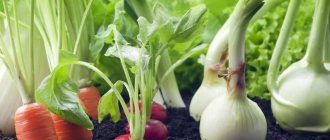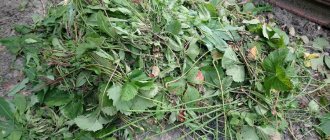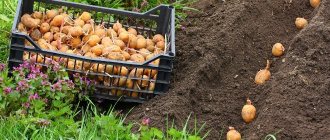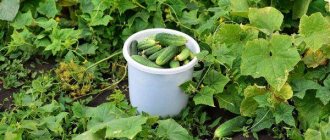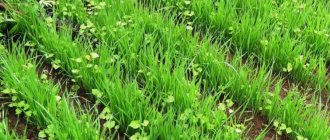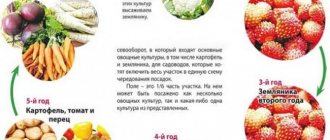Methods for planting raspberries
Before planting, you should know when to plant raspberries and how to choose the most suitable method.
Cluster scheme
The method is most often used by gardeners to propagate crops. A special feature is the landing speed. Suitable for small garden plots where you plan to grow several bushes. To use the method:
- mark the area;
- dig small holes up to 30 cm deep, each width should be 30 cm;
- a drainage layer and a layer of compost are placed on the bottom;
- everything is thoroughly watered and planting material is placed;
- the roots should be leveled, soil should be poured on top and everything should be compacted thoroughly.
Bush planting method
The distance between bushes is at least 150 cm. After planting, the seedling is thoroughly watered with warm water.
Belt method
This method makes harvesting easy. To plant raspberries using the tape method, follow the following algorithm:
- install stakes in a previously prepared area and pull ropes;
- trenches up to 40 cm deep are dug along the stretched ropes;
- prepare a nutrient mixture from manure and sawdust;
- up to 4 kg of nutrient mixture is used per meter of trench;
- distribute seedlings into trenches (the distance between bushes should be at least 40 cm);
- sprinkle with soil and compact.
Tape planting method
After the seedlings are planted, the beds are watered with plenty of water. The cuttings are pressed and a trellis is made, on which the bushes will later rest. Wooden or metal structures can be used as trellises. The advantage of such plantings is their compactness and attractive appearance. If the soil at the planting site is clayey, it is recommended to add a small amount of river sand to facilitate the passage of oxygen.
To form bushes, after young shoots appear, they are tied up with trellises. During the pruning period, the appearance of the bushes is formed, which facilitates the process of caring for the plant.
Trench method
The method is complex, but allows you to get large yields. Its feature is the uniform distribution of nutrients throughout the entire area. To carry out the landing, perform the following steps:
- In the prepared area, trenches are made with a depth of at least 50 cm. The area is prepared in advance, several weeks before planting.
- Add humus and ash to the trenches. This promotes rapid growth and high quality berries.
- The seedlings are placed in water for several hours and then dipped in mash, which consists of liquid clay and mullein.
- The seedlings are distributed over the trench at a distance of 30 cm from each other.
- Sprinkle with soil and compact.
- Water the bushes and place a layer of sawdust on top.
During the planting period, carefully ensure that the roots are straightened and the soil is evenly distributed between the root shoots.
Trench planting method
Another method is to plant raspberries in containers. The method allows you to plant raspberries in small areas. The peculiarity of this planting is that you can move the container with raspberries to absolutely any place. Buckets or other deep items can be used as containers. The disadvantage is the short growing period in one container. After 2 years, a second transplant is performed.
What can be planted on the plot after raspberries next year?
The main roots of raspberries are located at a depth of 1.5 to 2 m, the adventitious ones spread horizontally by 30–60 cm, and are located at a depth of 15 cm. Thus, it turns out that the plant draws nutrients from a fairly large area of soil.
The structure of a raspberry bush looks like this:
1 - fruiting branch; 2 - side branch; 3 - replacement shoot; 4 - offspring; 5 - leaded offspring; 6 - roots; 7 - adventitious buds on the roots; 8 - rhizome.
Restoration work on soils after growing raspberries is carried out in several stages. For 3 years, after uprooting the bushes, they change crops, paying attention to the level of their rhizomes in the soil. In the first season, only green manure plants can be planted.
Green manure for soil restoration
The main advantage of their use is the possibility of obtaining in a short time a unique organic fertilizer containing nitrogen, magnesium, zinc and calcium.
Such plants produce nitrogen in the greatest quantities, retaining it on their roots.
Thanks to this element, not only increases soil fertility, but also disinfects. When choosing this type of vegetation, you first need to familiarize yourself with its characteristics.
Having not sufficiently studied the processes of vegetation, gardeners are often faced with the fact that when planting fruit crops, green manure sprouts on the site for several years, and already poses a direct threat to their growth and development along with weeds.
This happens, for example, when planting sweet clover, because it is a perennial representative, and it is impossible to grow it in one season. In this regard, it is necessary to give preference to annual green manures.
In addition, one of the important stages is the timely harvesting of herbs - it must be done when the plants begin to produce buds and accumulate the maximum level of nutrients, while maintaining the delicate structure of the greenery. If the vegetation has already begun to form seeds, then you will not receive high-quality fertilizer.
List of green manure plants that will help restore the soil after growing raspberries:
- Oilseed radish - sow in rows at a distance of 15 cm, deepen 3-4 cm in increments of 2-3 cm, seed consumption per 100 m² is 200 g. Sowing can be done from April to August. Mow greens 1.5 months after planting. Due to the presence of essential oils in its composition, radish is a good repeller for pests and prevents the growth of weeds. The only drawback of the plant is the low nitrogen content in the greens in comparison with other green manures. Radishes should not be sown before planting cruciferous vegetables.
- Annual rye - sow scattered or in yards, planting the seeds to a depth of 3 cm. Raw material consumption per hundred square meters is 2.5 kg. Planting can be done from August 25 to September 20, mowing after the formation of green mass. It is better to plant only in regions with a fairly humid climate, since rye is very demanding on it and in areas with low levels of annual precipitation it dries out the soil greatly. The main advantages of the crop are the ability to suppress harmful microorganisms, including those of fungal origin, weeds, increase the level of nitrogen in the soil, and also lighten the structure of heavy soils.
- Phacelia - sow in rows to a depth of 3-4 cm from March to August. The consumption of raw materials per hundred square meters is 120 g. Mowing should be carried out 1.5 months after sowing. This representative is compatible with all crops without exception, is an excellent honey plant, suppresses the growth of harmful microorganisms in the soil, enriches it with nutrients, and improves its structure. The only drawback is the fairly high cost of planting material.
- Mustard - sow in rows to a depth of 3 cm, leaving row spacing 20 cm wide, from March to August. Consumption per hundred square meters - 300–400 g. Ready for mowing - after 1.5 months. Mustard does a good job of cleaning the soil from parasites and fungal spores, improves its structure, adding friability at a deep level, promotes the breakdown of sparingly soluble phosphates, and also reduces the rate of leaching of minerals.
It is best to sow green manure in the spring. Previously, in the fall, after cleaning the site, the soil is filled with fertilizers - 10 kg of manure and 20 g of superphosphate per m². Then the soil is dug up to a depth of 30 cm.
Corn, grapes and sea buckthorn: characteristics of each “neighbor”
Like the previous plant, corn can keep raspberry plantings from spreading excessively throughout the area without causing serious harm to existing bushes. The only thing that can harm the cereal crop in this case is to protect the raspberries from the sun's rays, which will negatively affect the size and taste of the future berry harvest.
Also find out why raspberry leaves turn yellow.
Neighborhood with grapes and sea buckthorn is more undesirable for raspberries, since the rhizomes of all three plants are at approximately the same level and will compete for nutrients and moisture in the soil. Since sea buckthorn is stronger in development, it is likely that all the bushes of the latter will begin to lag in growth and will soon completely wither away.
How to prevent raspberry overgrowth
If, during planting, the raspberry tree along the perimeter was not limited by underground fences made of slate or sheet metal, then inevitably every gardener will face the problem of raspberry tree growth. And the more diligently the raspberry growth is removed, the more actively it grows, filling everything around.
In this situation, a well-known agrotechnical technique will come to the rescue, allowing you to control and manage the growth of raspberry bushes. By planting some types of plants along the raspberry plantings, you can prevent its growth. These include:
1. Sorrel is a herbaceous perennial, undemanding in care, preferring fertile loamy soils. Tannins and acids contained in the root system of the plant have a restraining effect on the raspberry root system. Thus, sorrel sown along the raspberry tree in 2-3 rows will help control its growth.
2. Beans - grain or asparagus. The root system of this vegetable releases substances into the soil that inhibit the growth of raspberries. Beans - for this it is more convenient to use bush forms - should be planted around the perimeter of the raspberry field, thus creating a protective green fence.
Sorrel, thanks to the tannins it contains, inhibits the growth of raspberries
3. Metlitsa is an annual weed with a highly branched root that can have a restraining effect on raspberry plantings. Easily growing between raspberry rows, broom brings additional benefits by covering the soil and thereby preventing the evaporation of moisture from it.
Attention! Metlitsa, although it is a weed, has recently been in great demand in landscape design - it is often used as lawn grass
What crops can be planted after using green manure?
- After growing green manure, the area can be planted with the following crops:
- roses or hydrangeas;
- strawberries;
- pumpkin and tomatoes.
Roses or hydrangeas
Roses and hydrangeas perfectly restore soil acidity. These flowers repel pests and attract pollinating insects. They can be planted not only after raspberries, but also next to them. Before planting roses in the autumn, organic fertilizers are applied to the site, and for hydrangeas - phosphorus.
Strawberry
Strawberries can be planted in a place that was used for raspberries only after 3 years. The roots of the plant in question, just like the adventitious roots of raspberries, are localized at a depth of 15 cm, and in addition, the crops are affected by the same pests, so you must first let the soil recover, and then only build strawberry beds.
Pumpkin and tomatoes
Pumpkin plants are quite demanding on the composition of the soil. In this regard, after the raspberry plant, green manure is planted for the first year, then high-quality fertilizer is applied with manure (applied in the fall) and only then the pumpkin is planted.
Regarding tomatoes, there are no restrictions on planting after raspberries. Vegetation feeds on different types of minerals and is not affected by similar pests and diseases. Tomatoes can be planted almost immediately after raspberries. In addition, they can become excellent neighbors for raspberries.
The fact is that tomatoes emit substances into the atmosphere that repel pests from raspberries and also promote faster fruiting. In addition to tomatoes, you can plant potatoes and legumes after the raspberries.
By following the rules of crop rotation for raspberries, you can significantly improve the quality of the harvest. When selecting crops, the main thing is to study their botanical characteristics. In the first season, after harvesting the raspberries, it is better to give preference to green manure plants, and the next season, plant other crops.
What to plant next
In place of the old raspberry patch, almost all annual crops grow well: vegetables, herbs, flowers. However, before this, the soil should be allowed to rest thoroughly and the area should be sowed with green manure grasses and then incorporated into the soil. Vetch-oat mixture and phacelia are best suited for these purposes. In the fall, it is also recommended to manure the area well and apply mineral fertilizers.
Planting strawberries after raspberries is unacceptable, since weevil larvae may remain in the soil after uprooting the bushes. Due to common diseases and pests, it is undesirable to plant berry bushes after raspberries for 2-3 years: gooseberries, raspberries, honeysuckle, rowan, etc.
You should also wait a little while planting root crops. Raspberry is a stubborn young lady, and even after moving the bushes, young shoots appear in the soil every now and then, suppressing the development of beets, carrots, and radishes. Potatoes are an exception. In the process of several hillings, raspberry shoots are easy to remove, and in manured soil, loosened by the small roots of the predecessor, the tubers are formed even and large.
How to care for raspberries in open ground
Complete and regular care of raspberry seedlings after planting in spring or autumn is the key to successful establishment, normal plant growth and excellent fruiting. In no case should the basic stages of care be neglected; it is especially important in the first year of growing a plant. In addition, caring for the plant in open ground is very simple.
Immediately after the event, it is necessary to mulch the plant. The mulch layer is five centimeters. You can use sawdust, hay, humus, peat.
After planting, the raspberries (both remontant and regular) are pruned to a height of 20-25 centimeters. It is necessary to prune the seedling, because thanks to manipulation, survival will be faster and better, and it will also stimulate the growth of new shoots.
The most important element of care and cultivation is protecting raspberries before winter cold. To do this, at the first frost, you need to create a protective layer of peat around the seedling, a layer of about 15-20 centimeters, do not forget to remove the peat in the spring!
And if you live in regions where the plant may suffer from frost, for example, in Siberia, the Urals, the Middle Zone, the Volga region, then you also need to cover the seedling. To do this, you need to build a small frame around it, cover the frame first with agrofibre and then with polyethylene. In the spring, as soon as the first warm rays appear, you need to remove the shelter. But you should hurry with the shelter, because if you do it too early in the fall, the seedling may be destroyed.
If the planting was done in the spring, then you can put sheets of roofing material between the rows, it will make it easier for you to control weeds.
If you applied the recommended fertilizers to the planting hole, then you should not fertilize in the first year; the soil has the necessary supply of nutrients.
Video: rules of care.
Features of growing raspberries in the country in different regions
The location for the raspberry plant is chosen depending on the growing region:
in Siberia and the Urals it is important to choose a site that is warmer and without strong winds, possibly sacrificing sunlight; in the Moscow region, one has to take into account frequent winter thaws, after which frosts can damage the raspberries. Therefore, avoid places where melt water accumulates; in the south, you often have to hide the raspberry plant in partial shade so that it does not burn out. Caring for raspberries varies depending on the region somewhat more than planting
So, in the middle zone, bending the shoots to the ground for the winter is absolutely necessary, in Siberia they are covered with spruce branches or spunbond, or even roofing felt, and in the south they don’t even know what shelter for the winter is
Caring for raspberries varies somewhat more depending on the region than planting. So, in the middle zone, bending the shoots to the ground for the winter is absolutely necessary; in Siberia they are covered with spruce branches or spunbond, or even roofing felt, and in the south they don’t even know what shelter for the winter is.
In areas where frequent winds can blow away all the snow, raspberries are covered with spruce branches for the winter
In most southern regions of Russia and most of Ukraine, there is a different problem: summer heat, and in some places drought. Therefore, here raspberries are kept under a good layer of mulch all year round and they try to arrange drip irrigation.
Drip irrigation of raspberries is very convenient for their industrial cultivation
In Belarus, on the contrary, you rarely have to worry about watering, and due to high humidity, it is necessary to take measures to prevent fungal diseases: thin out plantings, carry out preventive spraying.
The peculiarities of growing raspberries in Crimea are determined by high summer temperatures and insufficient precipitation. The heat comes early, in the spring, when in the middle zone the weather is completely comfortable for raspberries. Therefore, raspberries are planted in Crimea in the fall, not earlier than the end of October. If you do this in the spring, the seedlings will not have time to take root, since by the end of April the temperature is likely to reach 30 ° C.
In Crimea, raspberries have to be planted not just in partial shade, but almost in the shade: between buildings, near the walls of houses, etc. At the end of May, all young shoots that appear are removed, and new shoots for next year are grown from those that appear later. The rest of the agricultural technology is similar to the generally accepted one.
Raspberries in Crimea have to be planted not just in partial shade, but almost in the shade, in order to protect them from too bright sun
Raspberries in summer cottages are a desirable berry, but labor-intensive. Planting it is not difficult, but you have to constantly make sure that it does not fill the entire garden, but spends its energy on bearing fruit in the place allotted to it. There is nothing unusual in caring for raspberries, but certain work must be done throughout the year.
More on the topic “Growing raspberries in a summer cottage”:
About remontant raspberries
Cottage, garden and vegetable garden. Dacha and dacha plots: purchasing, landscaping, planting trees and shrubs, seedlings, beds, vegetables, fruits Section: Our garden (Raspberry cultivation). About remontant raspberries. I planted some branches last year and overwintered well (nothing wrong with them...
I want to plant raspberries in the fall. Where is better
Raspberries in summer cottages are now blooming profusely and driving young shoots out of the ground. August, planting raspberries: how to choose a place and which ones How to protect yourself from raspberries? I want to plant raspberries in the fall. Where is better? August, planting raspberries: how to choose a place and what you need...
How to protect yourself from raspberries?
Dacha and dacha plots: purchase, landscaping, planting trees and shrubs, Raspberry seedlings! on our site, raspberries grow completely randomly and in completely August, planting raspberries: how to choose a place and what fertilizers are needed. How to protect yourself from raspberries?
Raspberries bloom in August?
I want to plant raspberries in the fall. Where is better? August, planting raspberries: how to choose a place and what fertilizers are needed. How to protect yourself from raspberries? Conference “Cottage, garden and vegetable garden”.
Raspberries and blackberries
August, planting raspberries: how to choose a place and what fertilizers are needed. Buying and planting raspberries is not difficult - but they will grow in one place for several years, so this place should be chosen and equipped carefully. It is usually recommended to plant two plants at a time...
about roses and raspberries
about roses and raspberries. ...I find it difficult to choose a section. Cottage, garden and vegetable garden. Dacha and dacha plots: purchase, landscaping, planting trees and shrubs, seedlings, beds, vegetables, fruits, berries, harvest. August, planting raspberries: how to choose a place and what fertilizers are needed.
How to beautifully arrange raspberries?
Raspberries in summer cottages are now blooming profusely and driving young shoots out of the ground. Vegetable garden in spring and summer: pest control and vegetable protection. Growing raspberries: how to increase the yield and how much to water. At the dacha they gave me the magazine Homestead Farming...
How to plant apple, raspberry and pear trees
August, planting raspberries: how to choose a place and what fertilizers are needed. Raspberries go well with apple and pear trees. Algorithm for submitting an application: 1. You choose a place where you consider it necessary to plant trees or bushes.
Recommend a raspberry variety... and where?
August, planting raspberries: how to choose a place and what fertilizers are needed. Planting raspberries. It is best to plant raspberries at the end of summer - from the middle. Several different varieties should be planted, since raspberries require cross-pollination.
Fighting raspberries
Growing raspberries, forming raspberry slices. Fight against raspberries. Arrangement of the site. Cottage, garden and vegetable garden. Raspberries in summer cottages are now blooming profusely and driving young shoots out of the ground. Vegetable garden in spring and summer: pest control and vegetable protection.
Raspberries
Dacha and dacha plots: purchase, landscaping, planting trees and shrubs, seedlings, beds, vegetables, fruits, berries, harvest. Raspberries in summer cottages are now blooming profusely and driving young shoots out of the ground. Last time we told you how to water and form...
August, planting raspberries: how to choose a place and what fertilizers are needed. Planting raspberries. It is best to plant raspberries at the end of summer - from the middle. Several different varieties should be planted, since raspberries require cross-pollination.
Good afternoon! Raspberries grow on my site
Raspberries in summer cottages are now blooming profusely and driving young shoots out of the ground. Vegetable garden in spring and summer: pest control and vegetable protection. Growing raspberries: how to increase the yield and how much to water. At the dacha they gave me the magazine Homestead Farming...
Raspberries
Dacha and dacha plots: purchase, landscaping, planting trees and shrubs, seedlings, beds, vegetables Raspberries. On the beds. Cottage, garden and vegetable garden. Dacha and dacha plots: purchasing, landscaping, planting Growing raspberries: how to increase the yield and how much to water.
Key points when using green manure
Having started cultivating a vegetable garden, having learned about which crops belong to green manure, you need to accept as true that certain rules are followed in the selection and cultivation of green manure.
Sowing is possible in autumn, spring and summer. In autumn, the first plantings are done at the very beginning. If harvesting has not yet been completed, the seeds are sown to the ripening crop. A little later it will be time to plant winter crops. Their shoots should appear only in early spring. Winter green manures are sown in October or even November. In spring, green fertilizers are planted in the soil as early as possible and cut off without allowing their seeds to ripen. In summer, such plants are sown and used in the same way as in spring; they can be planted along the edges of beds, as well as between rows, and used in the fall. The decision about which green manure to choose is made based on what crops will be planted in the garden. Plants of the same family as the main crop cannot be used. There is no need to plant the same green fertilizer in one place, it is necessary to alternate with others.
Typically, the green manure plants that are most often used are annual crops. However, perennials are also very effective in improving soil health. They are used when soils are extremely depleted. The available list of perennial green manures is quite wide, but I would like to highlight alfalfa and sweet clover due to their frequent use. After harvesting, the land cannot be left empty; it must be given the same protection as green manure at the phacelia level protects the soil, otherwise the soil will become depleted. Weeds immediately grow on empty soil and suck out large quantities of nutrients from it.
Novice gardeners generally do not know how to remove green manure from their plot. There is an opinion that they should be plowed into the soil, but it will be more useful if you use a flat cutter or hoe when harvesting. Plants are pruned into the soil, resulting in more beneficial roots and mulch formation. Having acquired basic knowledge about the use of green manure on the site, a novice gardener can increase the yield on his site without the use of inorganic fertilizers and pesticides to control insects.
Plants that repel pests
Raspberries are one of those plants that often suffer from insect pests, so the gardener will have to make every effort to protect the future harvest. A radical solution to the problem is the use of insecticidal chemicals, but if you need environmentally friendly berries, then it is worth studying the issue of beneficial crop compatibility in this regard.
It is best to plant raspberry bushes next to aromatic plants that can repel the pest. For example, they will grow well next to red elderberry, the smell of whose berries is clearly noticeable within a radius of several meters from the plantings. Marigolds, garlic, ferns, coriander and celery have also proven themselves well, often found not only next to raspberries, but also near blackberries or strawberries.
Plants that are compatible with each other mutually support each other throughout the entire period of growth and development, therefore, if you have not yet planted raspberries on your site, the issue of proper proximity should be given increased attention. Combined with responsible further care, this action will help achieve maximum yield and protect you from unnecessary problems.
Let's look at the diagram in reverse (what to plant after specific crops)
When figuring out what can be planted next year, you can do the opposite. Namely, to find out what exactly can or should be planted after certain types of plants. The list looks like this:
- After garlic. It is allowed and even very good to sow/plant potatoes or beets. It is important to remember that onions belong to the same group as garlic. This means that after it you can plant the same crops.
Tip: sometimes experienced gardeners plant garlic between potato rows or vice versa. Such proximity in the beds is very beneficial for both types of plants.
- After cucumbers. There are more options here. You can place potatoes, tomatoes, peppers, onions, carrots, beets, eggplants or garlic, dill on the plot. It is also allowed to plant radishes and turnips.
- After cabbage. Everything is the same as after the cucumber, plus different types of legumes, zucchini and squash, as well as pumpkin.
- After the pepper. Here you can plant everything that is allowed to be placed after nightshades. Such crops include garlic and onions, legumes, root vegetables, cucumbers, and greens. But you should exclude potatoes from root vegetables.
- After potatoes. Here it is allowed to plant bulbous crops, squash, zucchini and pumpkins, legumes, cucumbers and root vegetables. The list also includes cabbage.
- After the tomatoes. It is allowed to place legumes, cauliflower and white cabbage, and green crops. Sometimes it is permissible to plant root vegetables, onions or cucumbers.
- After beets, carrots, cauliflower and white cabbage, cucumber and onions feel great. It is permissible to plant tomatoes or garlic.
- After the zucchini, it is best to place eggplants, peppers or potatoes on the plot. Tomatoes are also acceptable.
The tables below provide visual information about what can be placed in vegetable gardens and when.
Interesting: Growing pumpkin correctly for a good harvest
Common mistakes when planting raspberries in spring
Every gardener wants the berries to grow large and tasty, getting a large harvest from the raspberry tree every season. This will be possible provided that the following errors are not made:
- Do not ignore defects, traces of diseases and parasites that appear on cuttings. If you notice this early, you can cure it without harming the bush.
- There should be no other bushes or large trees near the raspberries.
- Do not plant raspberries in the shade of buildings.
- Do not plant raspberries in clayey or heavy soils; they will not take root in such soil.
- Do not plant seedlings in a place where something previously grew immediately, take a short break.
- Carefully trim the raspberries so that this procedure does not harm the bush.
- Do not plant raspberries deep into the ground. If the neck of the seedling ends up in the ground, the stem will rot and the berry will die. But you also can’t leave the bush on the surface.
If you follow all these rules, the bush will delight you with a bountiful harvest of tasty and aromatic berries.
Raspberries are a very unpretentious berry, and if you follow simple rules, you can harvest a rich harvest of fragrant, juicy and very healthy raspberries. And if the climate in the region is mild, then the crop can be harvested even twice a year.
Neighboring plants for raspberries: good and not so good
Raspberries go well with apple, pear, and plum trees, but they cannot tolerate cherries at all: even when planted 2–3 m from them, raspberries begin to wither, become stunted, and bear fruit poorly.
Raspberries should not be planted close to sea buckthorn and black currant, since all these plants have roots in the same layer of soil. The sea buckthorn will gradually drive the raspberries out of their place, and the raspberries will sprout in the middle of the blackcurrant bushes, suppressing the latter.
You can’t plant raspberries next to strawberries, and not only because their roots are located at the same depth, but also because they have common diseases and pests. It is not recommended to plant a raspberry plantation after tomatoes and potatoes.
Conditions for good growth and fruiting of raspberries
In order for the plant to grow well and bear fruit in an open area, it is necessary to create suitable conditions.
Choosing the best place to plant bushes
It is recommended to select in advance the most suitable area where you can plant raspberry bushes. Experts advise choosing places that are well lit by the sun throughout the day. Partial shade is not suitable for growing berries, as shaded areas have high humidity levels. Also, for growing raspberries, select an area that is protected from strong gusts of wind, which can break the branches of the plant.
Required soil composition: how to prepare the soil for seedlings with your own hands
Fruiting directly depends on the characteristics of the soil in which the berries are grown. Therefore, it is necessary to prepare the soil in advance for planting raspberries.
Autumn is considered a suitable period for preparing the site for planting. Before the onset of autumn frosts, the soil is carefully dug up and cleared of remnants of weeds. Then it is fertilized with mineral and organic fertilizers. Experienced gardeners recommend adding more potassium and phosphorus fertilizers to the soil.
Dimensions and depth of the landing pit
In order for the planted plant to grow normally and produce a lot of harvest, you need to familiarize yourself with how to properly make a planting hole. The depth must be sufficient to accommodate the root system. When planting tall raspberry seedlings, the depth of the hole should not be less than 30 centimeters. If the seedlings are small, dig a shallow hole 15-20 centimeters deep.
Advantageous neighborhood
Raspberries can be grown near plants that cannot harm them:
- Apple tree. It is considered the most suitable neighbor for raspberry bushes. These plants live quietly side by side and protect each other from gray rot and scab.
- Dill. If you plant dill near the berries, the yield of raspberry seedlings will increase by 2-3 times.
- Pear. This fruit tree will protect seedlings from attack by insects and fungal diseases.
What can you plant in the garden after that?
Every gardener, both beginner and experienced, before the start of a new season, thinks through what and where he will plant. And the point here is not only about beauty and convenience, although aesthetic pleasure is not the least important. What is important is the depletion and enrichment of the soil, pest infestation, and increased productivity.
Consecutive planting helps restore soil
The basic rule that a gardener should know is that you cannot constantly plant a plant in the same place. Any crop can be returned to its place only after a few years, during which time the land is restored and enriched with necessary microelements and nutrients. But there are some exceptions to this rule. The place for planting potatoes, tomatoes, beans and strawberries can not be changed for 4-5 years.
The second rule is crop rotation. In order for the soil to have a good rest, but not to stand idle, it is recommended to alternately plant plants with deep, medium and shallow root systems. Thus, the plantings select beneficial substances “layer by layer”, giving the layers located above or below the opportunity to fully recover.
So, for example, after tomatoes or potatoes, which have a medium-developed root system, it would be good to plant root crops that take microelements from the deep layers of the soil, or crops that feed in the upper layers (cabbage, cucumbers or zucchini).
To replace beds with garden strawberries, knowledgeable gardeners plant “deep” legumes, carrots and beets. For the next season - “superficial”: zucchini, pumpkin, cucumbers. And then they complete the recovery period with onions and tomatoes. After such a break, you can safely return the strawberries to their original place.
But garlic and onions are universal plants. They can be planted before any vegetables and after any crops. However, you should not sow onions or garlic in the same place twice in a row.
And third. Areas where crops were sick and susceptible to pest infestation must be planted with plants that are resistant to these diseases or that sanitize the soil. As a rule, related species are prone to the same damage, for example potatoes and tomatoes, cucumbers and zucchini.
What is best to plant next to what?
It is appropriate to plant some plants not only after each other, but also next door. They are not antagonists, and on the contrary, they have a beneficial effect on each other.
Raspberries go well next to cherries. Raspberries and apple trees mutually heal each other, preventing the appearance of scab and gray rot.
Grapes are favored by the proximity of radishes and radishes. Parsley acts on grape plantings as a natural orderly, protecting them from damage by phylloxera. It is recommended to plant garden areas where ant colonies live with parsley - it repels annoying small insects.
Another useful property of parsley: it repels the main enemy of strawberries - slugs. If you want to protect the future harvest, sow curly greens between the berry bushes.
Beans are planted between potato furrows, next to cucumber beds, mixed with radishes, mustard, spinach, and corn. Thanks to their proximity to beans, these crops receive additional portions of the nitrogen they need. And for the beans themselves, ideal partners will be basil, oregano, yarrow and rosemary - these herbs reduce the risk of infection with bean weevil.
Peas also help enrich the soil with nitrogen. It is ideal as a neighbor for carrots, turnips and cucumbers, which in turn stimulate the growth of juicy and sweet pods. And the tomato, which produces fintocides, is a powerful growth stimulator for peas. Enhanced growth of peas is promoted by substances secreted by the mustard root system. In addition, mustard prevents the appearance of codling moths and suppresses the growth of weeds - it is usually used in combined crops.
The main enemy of cabbage is butterflies and their larvae deposited between the leaves. These insects are repelled by mint, chamomile, wormwood, thyme, and sage. The smell of aromatic herbs interrupts and masks the unique and attractive smell of ripening cabbage heads. Various varieties of lettuce protect cabbage from flea beetles, and borage herb drives away voracious snails. But celery, although it repels flea beetles, is itself an object of desire for cabbage whites - such a partnership is unlikely to be useful. The proximity of cabbage to onions, dill, potatoes, and radishes is quite acceptable, but being next to tomatoes, carrots and green beans is undesirable.
A favorite and indispensable vegetable in the diet of most residents of our country, potatoes sit well next to corn, eggplant, horseradish, garlic and white cabbage. These crops have different roots and do not interfere with each other, absorbing the necessary microelements and water from different soil layers. Coexistence with partner plants contributes to high and stable yields of the “second bread” and reduces the risk of its disease. Moreover, in such a neighborhood, growing potatoes, you can not change the place for several years. He loves potatoes (both on the table and in the beds) in a “green” environment - dill, garlic, onions, lettuce, spinach, as well as horseradish, radishes, carrots and cabbage. Horseradish bushes are most often planted around the perimeter of the area reserved for potatoes. Onions and garlic, releasing antibacterial fintocides in large quantities, protect against late blight.
Beans planted between potato sprouts saturate the soil with nitrogen and protect the plant itself from bruchus. Bush beans protect plantings from the Colorado potato beetle. Therefore, tender eggplants grow well in her environment. Gardeners widely use the ability of beans to repel onion borers and often create a “hedge” from it around cucumber rows, cabbage and beets.
Tomatoes are inherently “donors”; they bring more benefits to nearby plants than take advantage of other people’s abilities. Substances secreted by tomato greens drive away the codling moth and prevent scab in fruit trees and have a positive effect on the growth of legumes, cabbage and onions.
However, the tomatoes themselves will also benefit from proximity to onions and garlic. These plants protect cucumbers and tomatoes well from bacterial infections, but peas, beans, and beans do not like onions. But it goes well with carrots (they mutually protect each other from flies), strawberries, lettuce, radishes and parsley.
The principle of “do no harm” on a personal plot
If some combinations of garden and vegetable crops complement each other, stimulating growth and protecting from pests, then other plants get along very poorly in close proximity and cause forced neighbors more harm than good.
So, legumes do not tolerate the proximity to Cipollino and his brothers very well, and a flowerbed with long-blooming marigolds would obviously not be welcome here.
The walnut is an absolute egoist, suppressing any plant that gets into its “inner circle”.
Oddly enough, peas do not like being next to beans, and also negatively perceive being surrounded by tomatoes or rutabaga.
It is undesirable for cabbage to be in proximity to carrots, parsley and tomatoes. The ardent antagonists are cabbage and grapes; with such coexistence, both cultures suffer. It is aggressive against grapes and tomatoes, and it, in turn, suffers from cucumbers, beets, fruiting apple trees and cabbage (cauliflower, red and white cabbage).
Potatoes do not need the company of cucumbers and tomatoes; they do not tolerate pumpkin, celery and sunflowers well (except for a decrease in yield, in this case there is a high risk of late blight infection). The tubers will not be large, but the harvest will be rich if you plant potatoes next to raspberry shoots and fruit trees, in particular apple and cherry trees.
It is better not to alternate gooseberry bushes and currant bushes and plant them away from each other. A disease such as gooseberry moth is easily transmitted between these plants. And the close proximity of strawberry plantations and raspberry thickets provokes the proliferation of colonies of the berry pest - the strawberry-raspberry weevil.
Fruit trees are also not all good neighbors. It is better to plant peach and apricot at the other end of the plot, away from pears, apple trees and cherries.
Sea buckthorn, garden strawberries, eggplant, pepper and tomato have similar infections. And their close location during planting provokes the emergence and massive spread of diseases inherent in these crops.
Choosing a place to plant raspberries
How to plant raspberries correctly so that you can regularly enjoy the ripe red berry, but at the same time not have problems with its care? Even before planting seedlings, you need to choose a good place for its maintenance, with suitable conditions.
Raspberries love a lot of light, so they need to be grown in areas open to sunlight. There should be no shading unless the object is located on the north side and does not cast shadows on the bush
In addition, it is worth paying attention to the absence of drafts and cold winds. This is why raspberries are often grown on the south side of high hedges.
To grow raspberries, you need open areas next to hedges.
How raspberries grow on a certain soil also influences the choice of location. The shrub does very poorly in low-lying areas, that is, in ravines and holes. The fact is that in such places the groundwater is shallow, which is why the berry plant often suffers from floods and stagnant water. This situation is dangerous for raspberries, as the root system begins to rot and the stems die.
How long can raspberries grow in one place?
Regardless of the planting method, raspberries should not be kept in one place for more than 8–10 years. It practically stops bearing fruit. And not only because the root system is outdated or a large number of diseases and pests have accumulated. There is another side of the matter that for some reason receives little attention.
The fact is that the roots of all plants secrete toxins in order to suppress the growth of the roots of other neighboring plants. But when the same plant is grown for a long time in one place, too many of these toxins accumulate, and they begin to inhibit the plant itself that produces them.
Each plant has its own period of time during which this process occurs. So, when growing lettuce in the same place, the influence of its own toxins begins to affect itself already in the third generation. For peonies the process lasts for 15 years, but for raspberries it occurs after about 8–9 years. Even when the bush is rejuvenated, the plants remain depressed, since not only the renewal of the plant itself is required, but also a change of soil.
Rules for crop rotation when growing blackcurrants
Each type of plant has characteristic diseases and dangerous pests. Nutrient requirements also vary. All these factors are taken into account when drawing up recommendations for crop rotation.
Basic rules prohibit:
- plant after plants of the same family;
- grow after plants that have common pests;
- use a site where crops demanding the same microelements grew.
The best predecessors saturate the soil with organic matter and improve soil quality.
Why is it important to follow them?
During growth, plants absorb microelements from the soil. The nutritional value of the soil is replenished by applying fertilizers. But if the same substances are removed while others remain untouched, an imbalance occurs that interferes with the normal development of plants.
Insect larvae and pathogens accumulate in the soil, creating unfavorable conditions for growing crops.
Impact on growth and yield
Rotating crops reduces the risk of plant infection, which leads to better yields. Sufficient amounts of nutrients also have a positive effect.
Predecessor selection
Raspberries are sensitive to nitrogen content, so the best predecessors for them are legumes and grain crops, which saturate the soil with this useful element. Berry bushes feel quite good after vegetables, with the exception of nightshades. Potatoes, tomatoes, peppers, eggplants and other representatives of this family are considered the worst predecessors for raspberries.
To avoid contamination of the crop with dangerous viral, bacterial and fungal diseases, it is not recommended to plant raspberries where berry bushes previously grew. Strawberries are also an unsuccessful predecessor for raspberries. These berry crops have a common worst enemy - the raspberry-strawberry weevil, the females of which lay eggs in the buds and gnaw the pedicels.
Read also: Metal mesh for photos
How to plant
The bushes grow in one place for 6-8 years, so the raspberry planting scheme must be carefully thought out. This will help to properly care for the plantings and make harvesting easier.
You can plant raspberries in rows, keeping the distance between them
Site preparation
The site must be prepared in advance. It should be dug well to a depth of 30-40 cm, removing all the roots of weeds. Wheatgrass and thistle, as well as bindweed, are especially dangerous for this shrub. They grow quickly and can destroy young shoots. Fertilizers are required: organic matter, potassium sulfate, superphosphate.
Note! The best time to prepare and fertilize the site is autumn. When planting in autumn, this must be done 3-4 weeks in advance. After digging, you need to prepare holes or trenches
Width 50-60 cm, depth - 40-50 cm. It is recommended to remove the bottom layer of soil; only the top layer returns back to the hole, it is more fertile
After digging, you need to prepare holes or trenches. Width 50-60 cm, depth - 40-50 cm. It is recommended to remove the bottom layer of soil; only the top layer returns back to the hole, it is more fertile.
Step-by-step instruction
If the preparation for planting was carried out correctly, this process will not cause difficulties. But it is better to use step-by-step instructions.
- Dip the roots of the seedling in water for several hours. You can add any root formation stimulator to it.
- At this time, finish preparing the holes: dig up the soil, add ash and fertilizer if necessary.
- Place the seedling in the hole so that the replacement bud is 3 cm below ground level.
- Straighten the roots, none of them should look up.
- Sprinkle with soil, shaking the bush so that the soil fills all the voids between the roots.
- Pour out half a bucket of water, add fertile soil and compact it. The root collar should be at ground level.
- The seedling needs to be watered and the root area should be mulched. Straw, sawdust, peat, pine needles or even cardboard are used for this. This is necessary to prevent moisture loss.
Bush care
Caring for planted raspberry bushes is easy. After a week they need to be watered again. Then watering is necessary only depending on the weather. Further care consists of tying up shoots, timely pruning, protection from frost and annual feeding.
How to tie raspberries
For raspberries that took root last summer, no more than 4 young shoots are left in the bush for the next season. If more than 4 young shoots are left, the bushes become very thick, which leads, on the one hand, to poor lighting and, consequently, to a drop in yield, and on the other, to the spread of fungal diseases.
If you grow raspberries in rows, then you definitely need to tie up the stems, otherwise they will begin to bend towards the soil under the weight of berries or wet leaves, and this can lead to breakage of the stem at the base. To hold the stems in a vertical position, stretch 2-3 horizontal trellises made of strong wire or cord, which are secured to stakes driven into the ground at a distance of 2-3 m from each other.
If you make 2 such fences at a distance of 40 cm from each other on both sides of the plantings, then the raspberries do not need to be tied to the trellises. If there is only one fence, then you will have to tie the stems to each of the horizontal trellises.
If we move the fences to a width of about 50–60 cm, then last year’s shoots can be tied to one side, from which we will harvest, and there will be enough space left for the young shoots that appear. It will not be shaded by fruiting branches. As they grow, young shoots should be tied to the trellises of the second fence. This way you will separate last year's and young shoots. This makes caring for plants much easier.
To prevent raspberries from creeping out of the designated area, you must either dig slate to a depth of 30 cm and limit the plantings on both sides, or every spring and autumn cut boundary lines along the plantings using a spade bayonet. But you can do it differently - leave a turf about 40 cm wide on each side along the raspberry plantings, on which you constantly walk, trampling the grass. Raspberries do not like dense soil and will not spread their roots to a trampled area.
If, nevertheless, the growth appears in the wrong place, it should be removed by cutting it with a sharp shovel and tearing it out by the roots. It is useless to cut raspberry shoots with pruning shears, as they will grow even thicker.
Is it possible to plant onions and carrots next to raspberries?
Onions and carrots are good neighbors, so they are often planted side by side in open soil. Don’t worry if the beds with plantings end up close to the raspberry bush. It has nothing in common with them, which means the bushes will not suffer from diseases or vegetable pests. On the contrary, a sharp carrot or onion aroma helps repel insect pests and bushes, so raspberries will be very useful.
Did you know? When choosing a site for placing raspberry trees, you should give preference to places located near apiaries. Bees collecting raspberry nectar from flowers can increase crop yields by 60–100%.
Neighborhood with raspberries
For raspberries, the ideal solution is a separate bed on which the bushes of the crop are placed. Often there is no free space, so other types of crops are planted nearby that do not affect the development and fertility of raspberries.
What can you plant next to raspberries?
When choosing crops that will be placed next to the berry, it is necessary to take into account the depth of the root placement, as well as what nutrients are needed for development. Some types of shrubs and fruit trees that get along well can be planted near raspberries.
If you have any doubts about whether it is possible to plant blackberries next to raspberries in one garden plot, the answer is yes. Since these two crops coexist next door, however, a distance of 1 meter should be maintained between the bushes for comfortable plant care. Blackberries also prevent the development of diseases on the berry bush.
Apple tree
Raspberries and apple trees are good neighbors; the crops will develop and bear fruit. The roots of the apple tree penetrate much deeper into the soil and do not affect the bush. Raspberries loosen the soil, which allows more oxygen to penetrate into the soil. However, such a neighborhood is permissible until the apple tree begins to develop a crown; after the crown grows, it will shade the bush, which can lead to its complete death. Therefore, after a few years, the raspberry bush must be transplanted to a sunny place.
Pear
When planting a pear in the same bed with raspberries, problems may arise that will negatively affect the tree. Since the shrub has a root, which is located on the surface, which leads to the absorption of moisture. If it is necessary to plant raspberries and pears, it is necessary to maintain a distance of 4 meters between crops.
Plum
When planting plums and raspberries in the same bed, you need to choose a sunny place and water regularly, only in this case the neighborhood will be successful. The distance between the plum and the bush is at least 2-3 meters. This is necessary so that the plum root system can absorb the required amount of moisture.
Rowan
Planting rowan and raspberries in the same area prevents the occurrence of pests on the bush. Crops are saturated with different nutrients from the soil, so they do not affect each other. In such a neighborhood, it is necessary to ensure that the raspberries do not grow and regularly remove old shoots.
Honeysuckle
The culture can develop together with raspberry bushes. Raspberries help prevent problems such as the appearance of putrefactive bacteria in the root system. The raspberry rhizome loosens the soil and allows moisture to penetrate into the deep layers and nourish the roots of the honeysuckle.
Juniper
With such proximity, both crops develop and produce crops. Juniper helps repel pests from berries during the ripening period.
Barberry
If it is necessary to plant barberry and raspberry crops nearby, a distance of at least 2 meters must be maintained. Too close a neighborhood will result in the berry bush being shaded from the sun, resulting in a reduction in yield. Barberry can also contribute to the appearance of the unique taste of the berries.
Red and black currants
It is not recommended to plant currants close to raspberry bushes. The distance between crops should be 3 meters. Shrubs absorb the same nutrients, so when using this type of neighborhood, you need to take care of additional fertilizer.
Rose bushes
The rose is a good neighbor for raspberries, as it repels pests and attracts insects that pollinate the inflorescences and increase yield. Rose bushes also eliminate excessive soil acidity, which is necessary for the normal development of raspberry bushes.
Tomato
You can plant different varieties of tomato near the raspberry patch. Tomato bushes repel harmful insects that damage the berries. Tomatoes tend to release biological substances into the air that increase raspberry yields. Also, when asked what vegetables can be planted in the garden next to raspberries, it is necessary to note such crops as potatoes, peppers and parsley.
Dill
Planting dill in the same area as raspberries helps protect the berries from pests. Dill, spreading its scent, repels winged pests. The same result can be achieved when planting garlic on a plot.
Planting near oats will eliminate unwanted raspberry growth. Oats are planted around the berries, due to which the soil is loosened, and the plants cover the raspberry roots for the winter.
Important. The use of oats in raspberry fields helps protect the bushes from wind damage, and also acts as a natural fertilizer.
What plants should not be planted together?
Raspberries are a demanding crop for neighbors, so some types of plants can damage the bush and reduce yields.
Corn
When planting corn next to raspberries, the appearance of young shoots of bushes is reduced. This method will keep the raspberry plant in the required shape. However, corn can absorb the nutritional components needed by the berry and lead to a decrease in yield.
Grape
You cannot plant grapes near a raspberry tree. The crop reduces berry yields and leads to diseases. Grapes are shrubs that require constant moisture, which promotes the appearance of rot on the root system of the berry. It is recommended to maintain a distance of at least 4 meters between the raspberry field and the vineyard.

